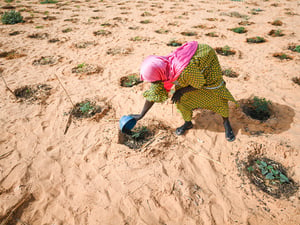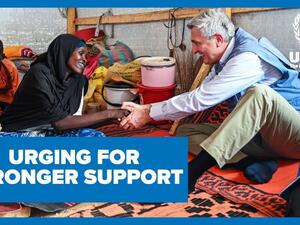Q&A: Building latrines for thousands of displaced every year
Q&A: Building latrines for thousands of displaced every year

Dominique Porteaud, UNHCR’s senior water and sanitation officer.
GENEVA, November 19 (UNHCR) - Dominique Porteaud is UNHCR's senior water and sanitation officer. The French national, who has forestry and public health engineering degrees, visits refugees camps and settlements for the internally displaced around the world to plan and build water and sanitation systems, including latrines. To mark today's World Toilet Day, he sat down with UNHCR Web Editors Leo Dobbs and Haude Morel and discussed his work. Excerpts from the interview:
Your role begins during an emergency. Tell us more
In an emergency situation, we need to quickly set up a system of latrines to avoid people defecating in the open and the spread of communicable diseases. These are temporary, communal latrines that are put in place from almost day one and maintained for the first three to six months. They are usually constructed from plastic sheeting and local materials on a plastic slab, or maybe a piece of wood that is cut. You dig a pit and put the wood on top. This helps ensure that human waste is not spread by people walking and that water sources are not contaminated.
What happens after the emergency period?
We build something more solid. One of the problems with emergency latrines is that they need to be maintained. For example, a block of five latrines may be used by some 500 people every day, but because they are communal nobody maintains them. Therefore you need to employ people to do that, which is not a great job and not really sustainable in the long term.
The next step is to move away from these communal latrines to household latrines . . . where each household or two households will have a common latrine . . . The ownership is with the people and they should clean their own latrines. But this does not always happen and that's why we do a lot of hygiene promotion activities, monitoring the state of the latrines, making sure they are clean, that there is a door to ensure privacy for women.
Who builds these latrines?
At the start, it will be UNHCR with the implementing partner. We pay people a salary, an incentive, to dig the pit and build the infrastructure. Because it's an emergency, everybody's in a rush to set up a system. With the household latrines, families dig their own pit and build their own infrastructure, with bushes, with trees, with mud, under the technical supervision of the implementing partner . . . at this stage it will be the refugees themselves doing it.
What happens if you don't build them?
A good example is Goma in 1994, when a million people crossed the border and, I think, about 50,000 people died because there was no proper sanitation and water supply. One of the major problems in Goma was that it was impossible to dig latrines because the [volcanic rock] ground was so hard and all the waste was spread around and contaminated the water that people were drinking. As a result, there was cholera everywhere.
You are part of UNHCR's health Unit. Why is that?
The reason why water and sanitation is under public health is because there is a strong link between public health and water and sanitation. For me, water and sanitation is the prevention, we prevent people from getting diaorrhea and other diseases. The public health people are more curative.
Tell us about the water distribution systems that are so important for sanitation in camps?
They need to be improved. During an emergency, [donor] money is usually flowing in and you can build a lot of pipelines, boreholes, and so on. When the emergency is over after a year, two years, three years, money is not coming in as it was before. Therefore the systems are getting old, people don't have any money to change the pipes or to do proper maintenance. A good example is Kenya, where the water supply system serves something like 250,000 people in three camps at Dadaab. But the bore has not been properly maintained, while the system is old and has not been maintained either. So we can't supply enough water to the population . . . I have been to Djibouti and I'm going next week to Ethiopia and I think it is a similar trend.
Are there innovations in latrine design and technology?
Yes, of course. If you look at the situation 15 years ago, you were just digging a pit and that was it. Now, a lot of people are talking about biogas [produced by the biological breakdown of organic matter in the absence of oxygen]. Every time someone defecates, you have a gas - methane. We use this gas to create energy and more and more people are looking at the possibility of reusing this gas as an alternative, environmentally friendly fuel. Or there is another thing called ecosan, which is ecological sanitation.
And then there are different designs in different places, whatever suits people best. If you travel around, you will see square latrines in some places, ring latrines in others, or some made with used clothes, plastic sheeting, bamboo or stone. You can find different designs and infrastructure and that's what makes it fun, because you need to use your imagination to make sure you have the structure best suited to the culture of the people
How many latrines does UNHCR or its implementing partners build?
It's difficult to say. On the basis of one latrine for every 50 people, there are an estimated 80,000 to 100,000 latrines in camps across the world currently. Maybe we fill in and replace 10-15 percent on an annual basis, which means we are building 10,000-15,000 latrines every year.
What about cultural considerations?
I will give you an example of something that happened in Indonesia after the [2004 Indian Ocean] tsunami. Green is the Muslim colour, something that you need to respect. One group built latrines and put green on the floor - that showed disrespect to the Muslims. The position of the latrine is important too; you should not have your back facing towards Mecca. Respect for women is another consideration. Usually, we separate latrines between men and women.








